There's an extraordinary metal about to enter a new super-cycle. That's because existing inventories are vanishing at an alarming rate. And it's giving smart investors a rare opportunity to potentially make a lot of money.
During the last upswing, prices of this natural resource climbed 349 percent. But the biggest money wasn't made buying the metal. It was made buying the miners.
Korea Zinc Company, Ltd.'s stock price went up over 465 percent. And Canada Zinc Metals' shares shot up 610 percent. Darnley Bay Resources Ltd. (TSX:DBL) even rose 667 percent.
Today, mining insiders understand that this metal's bull market has legs. Prices are just beginning a potentially record breaking rise. To take advantage of it, a leading mining industry expert founded Zinc One Resources (TSX-V:Z; OTC:ZZZOF).
This $67 million market cap company is set to become one of the newest zinc-mining players. After a recent acquisition, it's sitting on an excellent high grade zinc asset with room to grow. The zinc on the property is one of the highest-grade deposits of the metal in the world. And it's sitting right on the surface!
Essential to Life as We Know It
Zinc is one of the world's most important metals. It's also one of the least followed. But unlike gold, it isn't just pretty to look at.
Zinc is necessary to sustain life. Humans, animals and even plants need it for development and growth. It's even added to fertilizers and multivitamins.
But zinc's health benefits are responsible for just a fraction of the world's demand for the metal.
The world's emerging superpowers are eating it up.
The Red Dragon's Appetite for Zinc
China is the world's biggest user of zinc. That's because China spends more money on infrastructure than the U.S. and Europe combined.
Last year alone, China spent $2 trillion investing in its infrastructure. And that number is growing by $300 billion each year.
As an emerging first world nation, China's economic growth requires an increasing amount of raw materials and metals.
Since the rise of the Chinese economy in the the first decade of the 21st century, the world has witnessed a sharp increase in raw materials prices. Despite the financial crash in 2008, China's demand has grown substantially over the past twenty years.
In 1997, China consumed roughly 10 percent of global iron ore and zinc production. By 2007, the country's consumption had risen to 40 percent of the world's zinc production. Today, China is responsible for nearly 50 percent of the world's zinc demand. Not surprisingly, China's zinc utilization heavily influences zinc prices.
Chinese urbanization is a primary driver of economic growth. As the population migrates from the country to cities seeking a better way of life, China's consumption patterns are changing.
As incomes increase so too does the demand for consumer goods like automobiles and the raw materials needed to produce them.
This massive urban migration created an unprecedented demand for infrastructure, too. This construction, in turn, fueled an extraordinary need for the natural resources, especially zinc, to build it.
China's turbo-charged growth has helped fuel the most recent commodity booms. And the country's growth is accelerating once more.
As China's growth rate climbs, the country will demand more commodities to feed it – including zinc. China's increased need for the metal will continue to drive zinc prices higher.
Last quarter, China's economy grew faster than anyone expected. The country's annualized GDP growth rate rose to 6.9 percent.
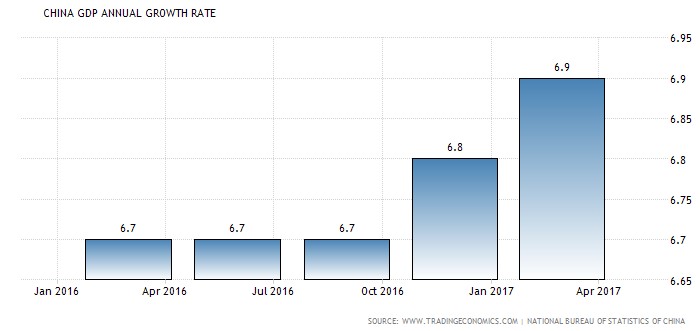
Source: www.tradingeconomics.com: National Bureau of Statistics of China
Higher government infrastructure spending and China's record-breaking property boom drove a lot of the surprise.
More construction means China is using more zinc to produce the galvanized steel necessary to construct the country's buildings, roads and bridges. But government funded construction isn't the only area of China's economy that is experiencing accelerated growth.
Private investment growth rose to 7.7%. And the Chinese consumer is also participating.
Income growth picked up, too. Disposable income in China is growing at 7 percent, the fastest rate since 2015. Retail sales bounced 10.9 percent, too, as sales of appliances, furniture and cars all increased.
The Chinese economy is firing on all cylinders. And it needs even more zinc to fuel it.
But China isn't the only emerging economic superpower gobbling up zinc. They will be competing with another country for this increasingly scarce resource metal.
India's Infrastructure Resurgence Depletes Stores
India, and its emerging economy, is also a major zinc consumer. As the country continues its investment in infrastructure such as power transmission, urban housing and transportation infrastructure, its demand for zinc to make galvanized steel and alloys will continue to rapidly rise.
By 2020, India is projected to be the fourth largest automotive producer in the world. Automobile manufacturing will further increase the country's zinc demand.
Last year, India's economy grew 6.6 percent according to the International Monetary Fund (IMF). In 2017, economic growth is expected to accelerate to 7.2 percent. Like China, the more India's economy grows, the more zinc the country will need.
But China won't be India's only competitor for zinc supplies. They will be bidding against the United States as well.
The Trump Trade Bonus
During his campaign, President Trump promised to invest in America's crumbling infrastructure. He said he wants to create jobs by rebuilding airports, bridges and roads.
All of those construction projects will call for galvanized steel and other zinc alloys to ensure the structures last.
When his spending plan is approved, America's need for zinc will increase, further adding to the increasing worldwide demand for the metal. With tight supplies, the price of the metal has nowhere to go but up.
The Natural Law of Supply Versus Demand
Zinc is the fourth largest consumed metal after iron, aluminum and copper. And in construction, zinc is a shining king.
That's because of zinc's anticorrosive properties. It bonds well to other metals, especially for steel makers it's a popular coating. Through the process called zinc galvanizing, thin layers of zinc are added to steel or iron ore to prevent rust.
Zinc is also a popular alloy. An alloy occurs when multiple metal elements are combined to create a substance that is stronger and more resistant to corrosion than the individual metals alone.
When zinc is combined with copper or other metals, new materials like brass are created. These new metals make up many household fixtures, technological components and automobiles.
But it isn't just manufacturers or construction projects that are driving zinc demand. Technology companies need it, too. From Apple and Tesla to Bombardier (BBD-B.TO), Russel Metals (RUS.TO) and Nevsun Resources (NSU.TO), the world's most innovative companies are buying up zinc.
Like all commodities, zinc prices rise and fall with supply and demand.
When demand is weak, zinc stockpiles build and prices collapse. And when prices of the commodity fall low enough, it isn't cost effective to pull the metal out of the ground. That's what has happened over the past few years.
Zinc mines have been closed. There is a lot less of the metal available when demand eventually increases. Industry insiders call it the commodities cycle.
But when demand for metals increases and there is less of the metal available, prices rise…quickly.
The same thing happened during the last great zinc bull market which started in 2004. That's when zinc supplies quietly began to fall.
Then prices of the commodity took off hitting new highs over the next three years.
The chart below shows that the cycle is repeating itself. Zinc supply isn't keeping up with growing demand. And the bull market for the industrial metal is just heating up.
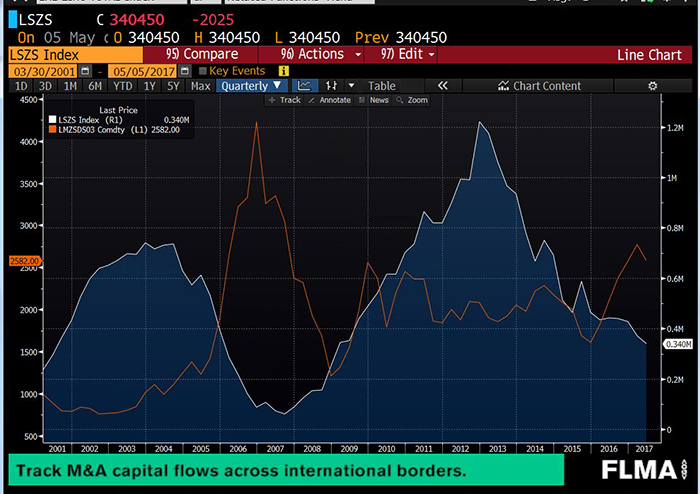
Source: Bloomberg
Last year, zinc demand became greater than the available supply for the first time in over a decade. So the price of zinc skyrocketed. In 2016, zinc prices shot up over 97 percent.
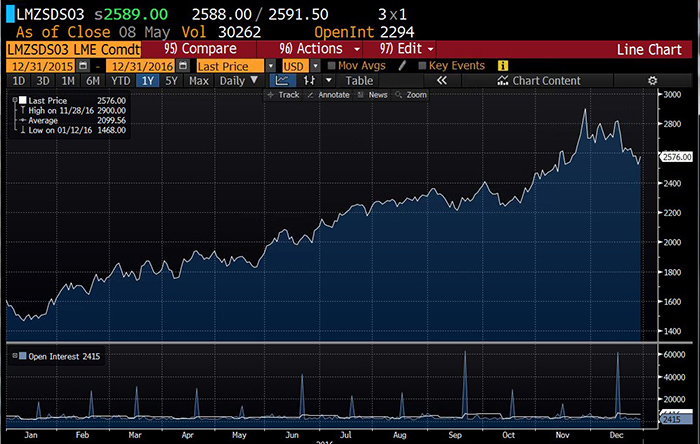
Source: Bloomberg
But the zinc bull market isn't over yet. In fact, it is far from being over. As you can see, during the first year of the 2004-2007 bull market run, zinc prices rose 63 percent in 2005.
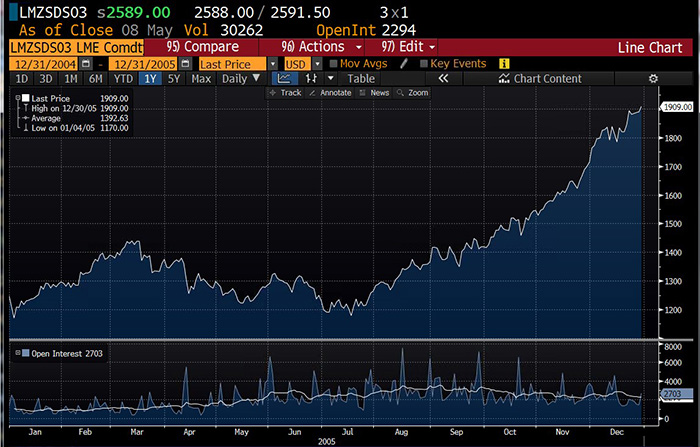
Source: Bloomberg
But the biggest gains actually happened in the last two years. That's when zinc prices increased 286 percent. These returns bested the first year's gains by more than 4 times.
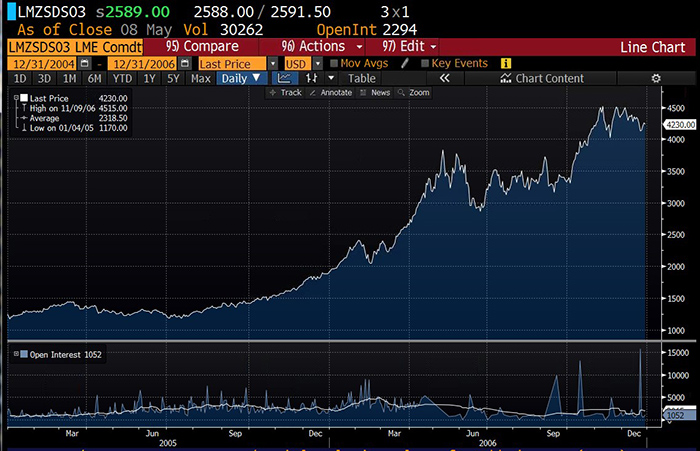
Source: Bloomberg
Although 2016 was a great year for zinc, the best gains are yet to come. And you have the chance to invest in it alongside a proven mining veteran.
An Opportunistic Mining Operator and Manager
Based in Vancouver, Canada, Zinc One (TSX-V:Z; OTC:ZZZOF) was founded by a successful mining veteran to capitalize on the current zinc bull market.
Zinc One's founder and CEO; Jim Walchuck has spent 37 years in the mining industry. Notably, he has worked for mining powerhouses like Barrick Gold (ABX.TO) and Sutton Mines.
Walchuck is an operator. He has experience managing multiple mining projects with millions of man-hours. That's why he recognized the zinc opportunity early and founded Zinc One.
Mr. Walchuck has built mines from the ground up. And in the past these mines became operational in extremely short periods of time.
When Mr. Walchuck was the mining manager for Barrick's Bulyanhulu Gold Mine in Tanzania, he oversaw the building of a multi-million-ounce, high-grade underground mine in under 7 years. Considering the comparable time it takes in the industry this is fast!
After nearly 4 decades in the business, he knows a good resource when he sees one. And he's an expert at identifying and maximizing profits when commodities prices take off.
That's why Zinc One just acquired the Bongará Zinc Mine (and adjacent Charlotte Bongará Zinc Project) in Peru. These proven and high-grade zincresources could make Zinc One a top "pure play" zinc producer.
Investors won't have to wait long for the company to make its mark. Zinc One expects to do extensive drilling on the Bongara Zinc Mine and move towards a preliminary economic assessment.
It's an aggressive but achievable goal due to Mr. Walchuck's vast experience building and operating a variety of mines and the adavanced stage of the project.
A Unique High-Grade Hibernating Zinc Mine
Located in Peru, zinc was first discovered in the Bongará area in 1974. Since then, several companies have completed exploration programs and even extracted zinc from the mines.
But when zinc prices headed south in 2008, the mine was closed. It has lain dormant ever since. That's why Zinc One (TSX-V:Z; OTC:ZZZOF) was able to scoop up such a valuable asset.
Zinc One's Bongará acquisition includes extremely high-grade zinc located along a 4-kilometer trend. This makes the mine even more valuable to Zinc One and the company's shareholders.
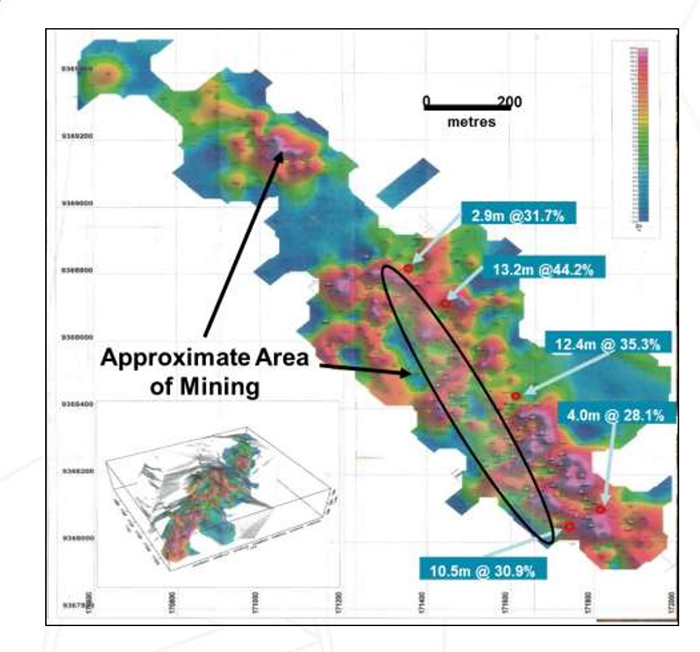
Source: Zinc One
Many zinc deposits are found deep underground and contain just 5 percent-8 percent zinc grades. But the Bongará deposit has 2.5 times higher grade zinc in it. Zinc makes up over 20 percent of the deposit. And in some areas, zinc concentration is as high as 25 percent-40 percent. A higher concentration in the ground at surface reduces Zinc One's extraction costs and increases profits.
Once it is back in production, the Bongará Mine Project will be one of if not the highest-grade zinc mine in the world. At a minimum, it will be in the top 1 percent for grade of the world's roughly 1,500 deposits the Company reviewed. Better still, its located in politically friendly Peru and past production records show greater than 90 percent of the zinc is recoverable!
But high-grade zinc, although important, isn't Bongará's only advantage. Being on surface it should see much lower mining costs than a comparable underground operation.
Easy Extraction Means Lower Costs
Bongará's zinc isn't located deep underground. It's sitting on top of the ground. You can literally see it!
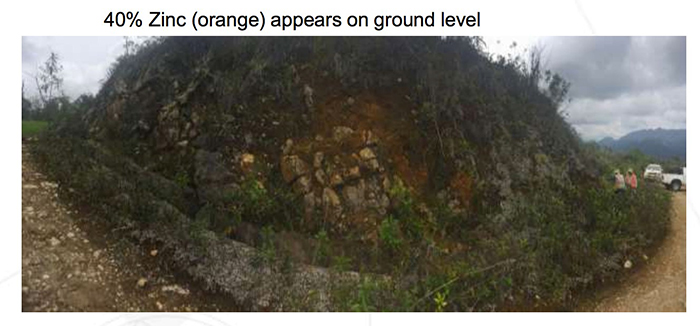
Source: Zinc One
This means the zinc can be extracted through open pit mining as it was before. Open pit or surface mining is a technique used to extract minerals like zinc from the earth in an open pit or burrow. It requires no tunneling or expensive construction of underground shafts, just earth moving machines.
Since open pit mining requires much less infrastructure build out, the costs are generally much lower than traditional tunneling underground. In laymen's terms, open pit mining is cheap! This makes Zinc One's zinc resources even more unique.
Undervalued Today and Way Undervalued Tomorrow
Today, 20 percent-25 percent grade zinc like the kind found in Bongará Mine Project is worth about $600/tonne rock. The last company to mine the area, Cementos Pacasmayo S.A.A. estimated that there were roughly 1,200,000 tonnes of around a 22 percent grade zinc remaining in a historical measured, indicated and inferred resource estimate. Zinc One (TSX-V:Z; OTC:ZZZOF) feels there is also room to expand this resource with more concentrated drilling and other measures. Zinc One expects to complete its updated resource estimate by the end of this year. This should be a lot of news flow to keep investors updated.
Along with other targets on the Bongará Mine Project site, the Charlotte Bongará property could add significantly more to Zinc One's zinc resources. High -grade zinc was found through drilling in 2011, but the exact size of the mineralisation has not been calculated yet. Zinc One benefits from existing resources with potential to expand them and years of established drill targets that could add much more
Zinc One believes that there could be 1.5 million to 2 million tonnes of around 20 percent zinc in the existing historical resource estimate on the Bongará Mine Project. That's a huge asset for a company with a market cap of just C$35 million.
Looking for the Next Bull Metal Market?
As an industrial metal, investors don't give zinc much respect. But bearish sentiment is beginning to change.
The new zinc bull market is just beginning. There's still time to get in on it.
Few companies have been focused on zinc because prices of the necessary metal have been depressed for so many years. There has been little zinc exploration or project development.
Zinc prices hit a five-year high in February before pulling back slightly. And this profit taking by early investors is creating a perfect buying opportunity.
Zinc One is in an enviable position to profit from the current zinc bull market. Since it's one of very few zinc focused exploration and development companies that could provide near term production, its stock price is tied to the price of the commodity.
As we saw in the last Bull Run, zinc rose 34%. But zinc miners saw their stock prices surge even more. Korea Zinc Company went up 465%, Canada Zinc Metals advanced 610% and Darnley Bay Resources investors received a 667% total return on their investment.
With its experienced management team, historically proven high-grade resources and expected lower production costs, investors will soon see that Zinc One offers investors a tremendous risk/reward to play the potential upswing in zinc prices over the coming years.
This little known $67 million market cap company is sitting on an incredible high grade zinc asset. The zinc located at the Bongará property is some of the highest grade in the world. And it's simply lying in plain sight on top of the ground.
Zinc One's management has built a company that is primed to soar alongside the price of the world's fourth most consumed metal. The fundamentals for zinc haven't changed. Demand is set to outpace supply for the foreseeable future. Zinc prices will rise. And Zinc One (TSX-V:Z; OTC:ZZZOF) is in a very strong postion to outperform the market.
Legal Disclaimer/Disclosure: This piece is an advertorial and has been paid for. This document is not and should not be construed as an offer to sell or the solicitation of an offer to purchase or subscribe for any investment. No information in this Report should be construed as individualized investment advice. A licensed financial advisor should be consulted prior to making any investment decision. We make no guarantee, representation or warranty and accept no responsibility or liability as to its accuracy or completeness. Expressions of opinion are those of Baystreet.ca only and are subject to change without notice. Baystreet.ca assumes no warranty, liability or guarantee for the current relevance, correctness or completeness of any information provided within this Report and will not be held liable for the consequence of reliance upon any opinion or statement contained herein or any omission. Furthermore, we assume no liability for any direct or indirect loss or damage or, in particular, for lost profit, which you may incur as a result of the use and existence of the information, provided within this Report.